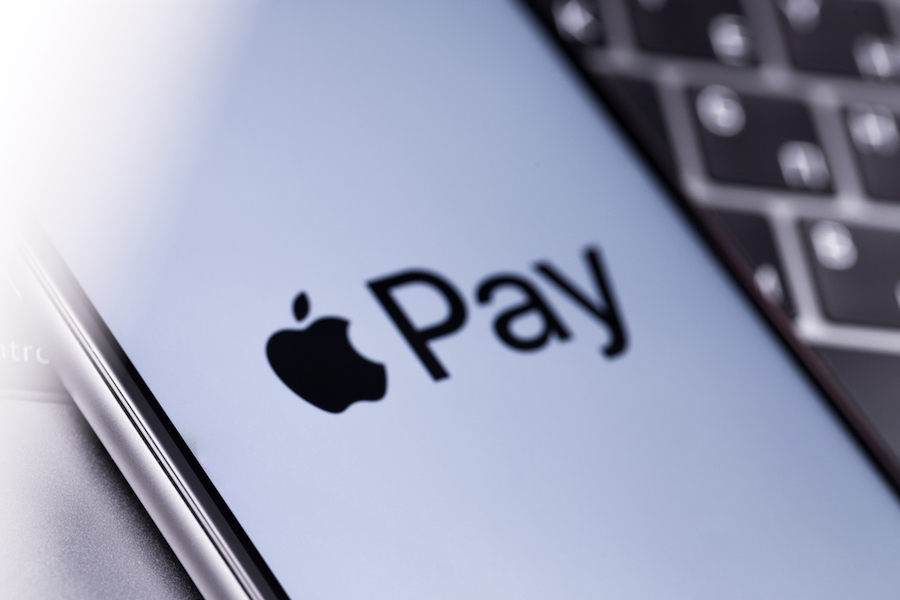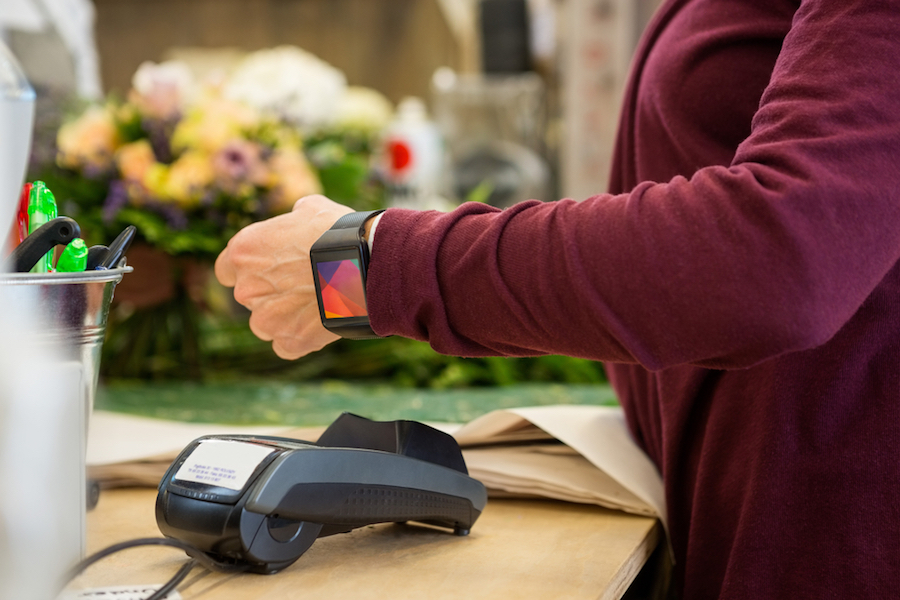In this 7-minute read:
- Top payments innovators and disruptors over the past decade
- Square, Stripe, etc.
- EMV/chip card adoption in the US
- Mobile wallets
- Contactless payments
- Easy, free ACH payments for P2P transactions
Credit cards came into popularity in the 1950s with Diner’s Club, American Express, and BankAmericard. These early pioneers created local and national card networks and introduced people (and businesses) to the convenience of paying with cards rather than checks or cash.
Early cards were simply cardboard business cards and payments had to be reconciled manually and facilitated in person or via the mail.
Many technological innovations have followed (can you believe the magnetic strip was invented way back in 1969?) and some have had a profound impact on how people pay and get paid for goods and services.
Accept credit card payments on any hardware and get the best software and processing experience with Womply Payments. Tell us about your business and we’ll match you with the perfect payment processor for your needs. 100% transparent pricing, no hidden fees, and industry leading rates from top processors. Click for more information or sign up for Womply Free!
We’re going to focus on 5 of the ways payments has changed in the last 10 years (with emphasis as how they are relevant to small businesses), and look at the companies and technology that have led the way.
1. Square, Stripe, and other disruptors to traditional payments processing
By far the most “disruptive” force in the payments space where small businesses are concerned is the rise of payments services providers that sidestep the traditional “merchant processor” system. The first and most influential disruptors were Square and Stripe, both founded in 2010, but many companies such as Clover and Toast have followed with a similar approach and varying offerings.
Stripe initially focused on online payments and online businesses, while Square was hugely influential and gained widespread use among small, local businesses due to the simple fee structure and nearly instant POS (point of sale) hardware they pioneered, which could turn any mobile phone with a headphone jack into a digital payments device.
Square even provided their stripe reader for free in many cases, and has since developed a line of POS terminals as well as small business software intended to make other small business tasks as straightforward to owners as they made digital payments.
Remember, while the new “disruptor” style of flat rate processing can be attractive to small business owners, a well-informed merchant services provider will likely be able to get you better rates and a more personalized experience overall, and can be a useful advisor about innovations and new technologies in the payments space.
You may also like: Credit card processing fees—what small businesses need to know
2. EMV or “chip” cards
It is now becoming familiar to “dip” or insert a credit or debit card into a payment terminal, but remember this is a relatively new phenomenon.
EMV stands for Europay, Mastercard, and Vias, who where the three pioneers of “smart chip” technology for credit and debit card authentication. Believe it or not the first version of EMV came out in 1994, and in Europe its adoption was widespread, but in the U.S. it took until 2015 for card issuers to start forcing adoption by businesses, and a deadline for universal adoption for all businesses has been pushed later and later due to various problems.
However, where physical card use is concerned, the EMV/chip card system is here to stay and will be used for the foreseeable future, due to the much lower rate of fraud and simpler authentication afforded by this technology.
3. Mobile wallets and payments
In order for a cellular phone or other device to act as a payments portal or mobile wallet, there must first be a robust internet and cellular network, and the appropriate mobile device hardware and software, to facilitate it.

So, though internet payments services providers such as PayPal were gaining popularity in the early 2000s among online shoppers (and especially among eBay users), Apple Pay (as one example of a mobile payments platform) wasn’t around until 2014, and it has seen significant popularity and adoption only in the past few years.
Today, “mobile wallets” such as Apple Pay, Samsung Pay, Google Pay, and others are increasing in use by consumers and adoption by businesses for many reasons. The primary reason is that everyone has a smartphone, and nowadays a physical wallet, with physical cash, cards, or (heaven forbid) a checkbook, is entirely unnecessary and to many people seems positively archaic.
Smart phones have powerful encryption and the ability to verify users, so that can help remove the time-consuming and risky burden of verification from the processor and/or the business owner.
Customers using mobile wallets can also often pay more quickly, which improves customer satisfaction, which in turn improves loyalty and increases revenue for business owners.
Furthermore, since the advent of online banking and the widespread use of apps for every aspect of finance, payroll, budgeting, etc., more customers than ever feel perfectly safe handling all of their banking and payments needs online via their mobile devices, and some have never set foot in a brick-and-mortar branch of their bank. It is indeed a brave new world for consumers as well as business owners.
4. Contactless payments
Contactless payments are exactly what they sound like: the ability to accept and verify digital transfer of funds without any contact required between the customer and terminal, customer’s card and terminal, cashier and card, or otherwise.
In addition, since the authentication is set up beforehand by the device’s software, setup, login, and/or face- or fingerprint recognition, there is often no further need for ID verification at the point of sale, and the customer need not carry any other form of payment or ID.
This has become known as “tap to pay” (though you don’t actually have to “tap” a card or device on any surface or terminal; just get within the required proximity).
This has obvious advantages in speed and convenience for both businesses and customers, and is particularly useful during a situation like a pandemic since there is no required physical contact between the device/card/wearable and the payment terminal, nor the exchange of any item between cashier and customer.
Some well-known contactless-enabled examples include Apple Pay, Samsung Pay, Google Pay, and Fitbit Pay. Today, contactless payments can be made via certain “smart” credit cards, debit cards, key fobs, smart cards, “wearables” (such as wristbands, watches, rings, etc.), or other devices including smartphones (as discussed above), that are capable of using radio-frequency identification (RFID) or near field communication (NFC).
Contactless payments were pioneered by gas stations back in the 1990s, who issued unique key fobs that enabled loyal customers to purchase fuel at contactless-enabled pumps quickly and conveniently. However the boom in contactless payments didn’t really start happening until the past few years, as more and more businesses bought into the concept and asked their processors to help them get set up with the proper hardware/POS terminals to accept them.
Since COVID-19, the demand for and interest in contactless payments has skyrocketed, and businesses as well as consumers are making the move to get set up for these useful forms of payment.
Since theft of a device (or digital hacking) is a possibility, there is an increased risk of fraud with contactless payments compared to, say, an EMV chip card payment backed up by a PIN or signature and/or ID, so businesses sometimes restrict contactless payments to lower-dollar-amount purchases.
However, the vast majority of American small businesses deal mostly in lower-dollar-amount transactions anyway, so this doesn’t seem to be a huge issue as far as adoption or use.
You may also like: best practices for cashless, chip, and contactless payments
5. Easy, no-fee ACH payments like Venmo and Zelle
Venmo, now owned by PayPal, was officially started in 2009 as a way for music fans to text a payment to their favorite bands and receive an MP3 file in return. However it wasn’t until the past few years that no-fee P2P (person-to-person) ACH (Automated Clearing House) payments have become widely adopted among American consumers.
It’s very easy to send money to another person via Zelle (usually using your mobile banking app or website) or Venmo, and it’s quicker and far more convenient than sending cash, check, or a money order. These payments are made and verified nearly instantly by participating banks, in a similar fashion to all the millions (hundreds of millions, really) of ACH transactions they facilitate daily.
Venmo payments to merchants (businesses) were forbidden before 2015, and although a growing number of businesses are accepting Venmo payments, but from what we can determine it can be problematic for businesses to accept Venmo payment in exchange for goods and services.
The option may be offered by your payments provider/point of sale technology, sometimes in association with your business PayPal account or card, and if this is the case you’re most likely good to go. But according to Venmo:
“Venmo is designed for payments between friends and people who know and trust one another.
“You may use Venmo to pay for goods or services using a Venmo card [emphasis added] at merchants that accept the card or through mobile websites or apps that are approved to offer Venmo as a payment option. If available, the option to pay using Venmo will appear as a Venmo-branded payment button at checkout or, in some cases, may appear after you first select PayPal as your payment method. Additionally, you may use Venmo to pay for goods and services when directly given the option to do so by Venmo.
“Venmo may NOT otherwise be used to receive business, commercial or merchant transactions, meaning you CANNOT use Venmo to accept payment from (or send payment to) another user for a good or service.”
We recommend you contact your payment processor and ask them whether they can get you set up to accept Venmo payments. Chances are, lots of your customers are already using Venmo.
Let Womply help you find the perfect processor for your small business
The payments industry can be very confusing and overwhelming for small business owners. However, Womply has direct relationships with a number of the nation’s top processors, and we can help you navigate the complexities and get you set up with a processor that not only provides competitive rates on reliable credit card processing, but can give you additional tools that can help your transaction data into actionable insights to help you attract and retain more customers!
Click here to check out our small business loans resources. Learn more, plus get free reputation monitoring and customer insights when you sign up for Womply Free!